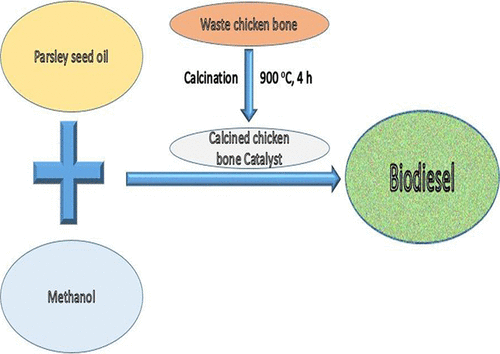Our official English website, www.x-mol.net, welcomes your
feedback! (Note: you will need to create a separate account there.)
Yield Response from the Catalytic Conversion of Parsley Seed Oil into Biodiesel Using a Heterogeneous and Homogeneous Catalyst
ACS Omega ( IF 3.7 ) Pub Date : 2021-09-20 , DOI: 10.1021/acsomega.1c01855 Sarah Oluwabunmi Bitire 1 , Tien-Chien Jen 1 , Mohamed Belaid 2
ACS Omega ( IF 3.7 ) Pub Date : 2021-09-20 , DOI: 10.1021/acsomega.1c01855 Sarah Oluwabunmi Bitire 1 , Tien-Chien Jen 1 , Mohamed Belaid 2
Affiliation

|
This research work is focused on the investigation of the optimum condition for parsley seed oil (PSO) trans-esterification using a heterogeneous (CCB) and homogenous catalyst (KOH). The process parameters (alcohol: oil ratio, temperature, and catalyst loading) were varied to examine their effect on the percentage biodiesel yield using a Box–Behnken design embedded with the response surface methodology (RSM). Also, the heterogeneous catalyst was synthesized by calcining waste chicken bones at 900 °C for 4 h. Thereafter, scanning electron microscopy (SEM), X-ray fluorescence (XRF), energy-dispersive X-ray spectroscopy (EDS), Fourier-transform infrared spectroscopy (FT-IR) and X-ray diffraction (XRD) analysis were utilized to determine the morphology and elemental composition. Thermogravimetric analysis (TGA) was also adopted to assess the effect of calcination temperature on the prepared catalyst. The characterization analysis revealed the presence of hydroxyapatite as the major component, and the reusability test showed that it exhibited good catalytic performance for PSO transesterification. However, the optimization study revealed that the optimum reaction conditions of 9:1 alcohol: ratio, 60 °C reaction temperature, and 3 wt % catalysts gave 90% biodiesel yield, while the homogenous catalyst (used as the control transesterification experiment) under the same conditions gave an average yield of 96.33%. Gas chromatography–mass spectrometry (GC–MS) was utilized to characterize the produced biodiesel. Furthermore, the fuel characteristics of biodiesel were within the specifications of the ASTM D6751.
中文翻译:

使用多相和均相催化剂将欧芹籽油催化转化为生物柴油的产量响应
这项研究工作的重点是研究使用多相 (CCB) 和均相催化剂 (KOH) 进行欧芹籽油 (PSO) 酯交换的最佳条件。使用嵌入响应面方法 (RSM) 的 Box-Behnken 设计,改变工艺参数(醇油比、温度和催化剂负载量)以检查它们对生物柴油产量百分比的影响。此外,多相催化剂是通过在 900°C 下煅烧废鸡骨 4 小时来合成的。此后,利用扫描电子显微镜 (SEM)、X 射线荧光 (XRF)、能量色散 X 射线光谱 (EDS)、傅里叶变换红外光谱 (FT-IR) 和 X 射线衍射 (XRD) 分析确定形态和元素组成。还采用热重分析(TGA)来评估煅烧温度对制备的催化剂的影响。表征分析表明羟基磷灰石作为主要成分的存在,重复使用性测试表明它对PSO酯交换表现出良好的催化性能。然而,优化研究表明,9:1 醇: 比、60 °C 反应温度和 3 wt% 催化剂的最佳反应条件得到了 90% 的生物柴油产率,而均相催化剂(用作控制酯交换实验)在相同条件下的平均产率为 96.33%。气相色谱-质谱(GC-MS)用于表征生产的生物柴油。此外,生物柴油的燃料特性符合 ASTM D6751 的规范。
更新日期:2021-10-06
中文翻译:

使用多相和均相催化剂将欧芹籽油催化转化为生物柴油的产量响应
这项研究工作的重点是研究使用多相 (CCB) 和均相催化剂 (KOH) 进行欧芹籽油 (PSO) 酯交换的最佳条件。使用嵌入响应面方法 (RSM) 的 Box-Behnken 设计,改变工艺参数(醇油比、温度和催化剂负载量)以检查它们对生物柴油产量百分比的影响。此外,多相催化剂是通过在 900°C 下煅烧废鸡骨 4 小时来合成的。此后,利用扫描电子显微镜 (SEM)、X 射线荧光 (XRF)、能量色散 X 射线光谱 (EDS)、傅里叶变换红外光谱 (FT-IR) 和 X 射线衍射 (XRD) 分析确定形态和元素组成。还采用热重分析(TGA)来评估煅烧温度对制备的催化剂的影响。表征分析表明羟基磷灰石作为主要成分的存在,重复使用性测试表明它对PSO酯交换表现出良好的催化性能。然而,优化研究表明,9:1 醇: 比、60 °C 反应温度和 3 wt% 催化剂的最佳反应条件得到了 90% 的生物柴油产率,而均相催化剂(用作控制酯交换实验)在相同条件下的平均产率为 96.33%。气相色谱-质谱(GC-MS)用于表征生产的生物柴油。此外,生物柴油的燃料特性符合 ASTM D6751 的规范。











































 京公网安备 11010802027423号
京公网安备 11010802027423号